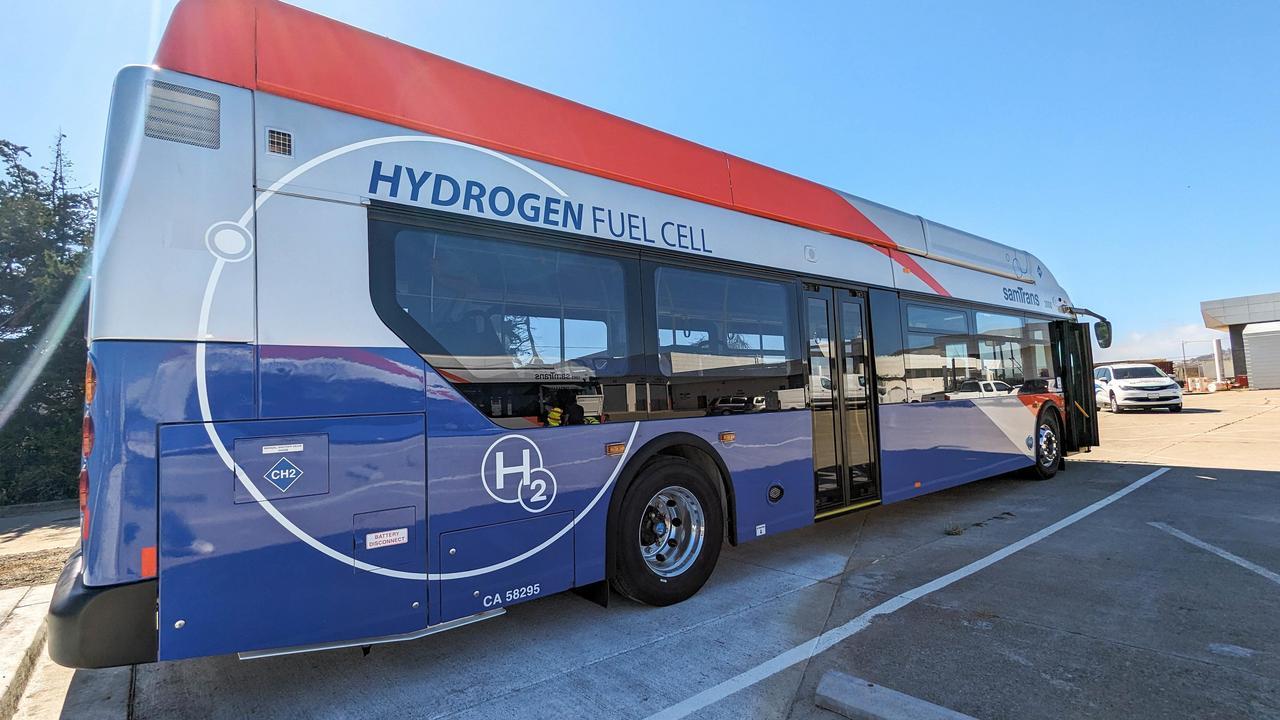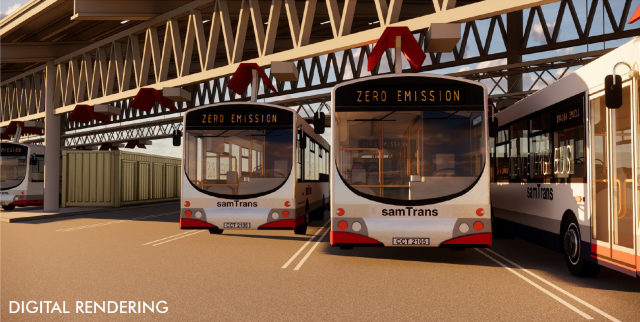SamTrans is transitioning its diesel bus fleet to meet the goal of a 100% zero emission fleet by 2034
SamTrans is investing in battery electric and hydrogen fuel cell buses to do its part to reduce greenhouse gas emissions, fight climate change, and keep our air clean and communities healthy. SamTrans buses are an affordable and convenient way to get you wherever you need to go—and now SamTrans is beginning the process of making them emission-free!
California requires all public transit agencies with buses to transition to a 100% zero emission bus fleet by 2040. SamTrans is on track to complete the transition by 2034, six years ahead of the state deadline.
In 2020, the SamTrans Board of Directors approved a plan to convert the fleet to 100% zero emissions. Since then, the Board has approved the purchase of 118 hydrogen fuel cell buses (FCEBs) and 37 battery electric buses (BEBs) for the SamTrans fleet.

SamTrans’ zero emissions future includes both battery electric and hydrogen fuel cell buses
SamTrans is making the transition to a 100% zero emission fleet by introducing both battery electric and hydrogen fuel cell technology.
Having a fleet made up of both electric and hydrogen buses will help the SamTrans bus system be more flexible, resilient, and adapt to changes in technology. FCEBs make it possible for SamTrans to be independent from the electrical grid, allowing SamTrans to operate vehicles during an emergency without relying on a steady stream of electricity.
BEB and FCEB technology and costs continue to improve and change at a quick pace. By considering and pursuing both options, SamTrans will make more informed decisions about technology for the remaining fleet.
Unlike conventional buses, BEBs use an onboard battery pack to propel the bus instead of burning diesel. BEBs do not produce greenhouse gas emissions or harmful exhaust that reduce air quality.
In a hydrogen fuel cell, hydrogen and oxygen are combined to generate electricity, heat and water. The fuel cell converts the energy into usable electricity to power each bus. While electric batteries need to recharge, hydrogen fuel cells continue to produce electricity while hydrogen is supplied. FCEBs can be refueled quickly and travel long distances. They have a lot in common with the diesel buses we use today in terms of infrastructure, operations, and maintenance, except they only emit water.
SamTrans is committed to complying with the highest safety standards in the deployment of zero emission vehicles and construction of operation and maintenance infrastructure. SamTrans performs rigorous inspections and testing on zero emission vehicles and equipment before they are available to the public and on an ongoing basis. SamTrans also follows safety procedures for handling fuels and energy sources. Whether it be gasoline and diesel, or electric batteries and hydrogen, it is important to handle all energy sources with care.
Hydrogen is safer than conventional fossil fuels because it is non-toxic and safe to breathe. Many conventional fuels are toxic or contain toxic substances and generate harmful air pollution. Hydrogen fuel cell vehicles only produce water, and a hydrogen leak or spill will not contaminate the environment or threaten the health of humans or wildlife.
Battery electric vehicles produce no emissions and have important safety features. Batteries are temperature-controlled, have protective packaging, and are separated from passengers.
12/06/23 - Update of Innovative Clean Transit (ICT) Plan – Meeting Recording | Slide Deck
05/27/22 - Zero emission bus update at the SamTrans Special Board of Directors Meeting
Feasibility of 10 Fuel Cell Electric Bus Demonstration (July 2022)
SamTrans partnered with the Center for Transportation and the Environment (CTE) to evaluate FCEB performance and fuel consumption, fueling infrastructure solutions, and facility and maintenance needs. The evaluation included a test run of a FCEB on SamTrans routes, a site walk, and market survey of potential fueling solutions and fuel supply sources for the fleet. To receive a copy of the evaluation, email zeb@samtrans.com.
Draft Initial Study/Negative Declaration (ADA compliant) - SamTrans ZEB Implementation Project
The public comment period took place between September 15 - October 6, 2022.
12/06/23 - SamTrans set to make largest zero-emission bus purchase in the agency’s history
08/15/23 - SamTrans Launches First Bus in New Generation of Zero-Emission Vehicles
07/07/23 - California Gives Financial Boost to Emission Zero Project at SamTrans
05/15/23 - SamTrans Gearing Up to Operate Its First Zero-Emission Buses
06/07/22 - SamTrans to Purchase 30 Zero-Emission Buses
09/02/21 - SamTrans Awards Contract for Electric Bus Infrastructure at Bases
12/02/20 - Transit District Board Adopts Plan for Zero-Emission Bus Service
Frequently Asked Questions – SamTrans Zero-Emission Bus Transition
Below are the most frequently asked questions regarding SamTrans’ transition to zero-emission buses. If you do not see your question addressed below, please feel free to email zeb@samtrans.com.
Why is SamTrans replacing its diesel fleet with zero-emission buses?
SamTrans is investing in zero-emission buses to do its part to reduce greenhouse gas emissions, fight climate change, and keep our air clean and communities healthy. California requires all public transit agencies with buses to transition to a 100% zero-emission bus fleet by 2040.
How long will it take to transition the fleet?
SamTrans’ goal is to convert the full fleet to zero-emission technology by 2034, six years ahead of the state mandate. This will save significant costs and avoids any future diesel bus purchases.
How is SamTrans paying for this?
There is an overarching funding need for transit agencies transitioning to zero emissions. SamTrans has secured several state, regional, and federal funding opportunities for new buses and infrastructure. However, the transition is not fully funded, so SamTrans is actively pursuing additional opportunities.
What kind of zero emission bus technology is SamTrans transitioning to?
SamTrans is transitioning its diesel fleet to battery electric and hydrogen fuel cell electric buses. The SamTrans Board of Directors has approved the purchase of 118 hydrogen fuel cell buses (FCEBs) and 37 battery-electric buses (BEBs) for the SamTrans fleet.
Having a mixed fleet will help the SamTrans bus system be more flexible, resilient, and adapt to changes in technology. BEB and FCEB technology and costs continue to improve and change at a quick pace. By considering and pursuing both options, SamTrans will make more informed decisions about technology for the remaining fleet.
How are BEBs and FCEBs different?
BEBs are powered by rechargeable batteries. These buses store electricity in onboard batteries, which is then used to power an electric motor that drives the vehicle. BEBs have a range of around 180-200 miles and take 4-6 hours to charge.
FCEBs have hydrogen fuel cells. In a hydrogen fuel cell, hydrogen and oxygen are combined to generate electricity, heat, and water. The fuel cell converts the energy into usable electricity that is stored in battery packs to power each bus. Refueling a hydrogen bus is similar to refueling a conventional gas or diesel vehicle. FCEBs have a range of around 260-300 miles and take 5-20 minutes to charge.
Are BEBs or FCEBs better for the environment?
Several factors are considered when determining the environmental benefits of a new technology. Both BEBs and FCEBs have zero GHG emissions coming out of the tailpipe.
Currently, most hydrogen fuel is created through steam methane reformation, but there is a lot of work underway to make greener forms of hydrogen by using renewable energy and water electrolysis. We are likely to see growing adoption of hydrogen fueled vehicles. There is significant state and federal interest in funding hydrogen production. For example, California has a special initiative called ARCHES to accelerate renewable hydrogen projects and infrastructure.
Beyond GHG emissions, we can also look at how environmentally sustainable the vehicle is itself. Hydrogen buses generate much less battery waste than BEBs. Vehicle batteries are not yet commonly commercially recyclable, leading to hazardous waste at the end of their life. A BEB needs six battery packs to operate, compared to an FCEB, which only uses two battery packs.
Where is SamTrans getting its fuel and power?
The hydrogen fuel is being delivered by Plug Power, the company that installed the refueler. Plug Power will deliver hydrogen fuel to the site for three years. The power for the battery electric buses is obtained from PG&E, accessible through BEB charging infrastructure.
How is SamTrans training its workforce to work with these new buses?
Every operator employed by the district will receive one-on-one personalized training, including safety protocols and behind-the-wheel training before they can operate our FCEBs and BEBs. All training will be provided in-house by our mechanic instructors.
Is hydrogen safe to use as fuel?
Yes, hydrogen is as safe as other fuels and has been used since the 19th century. Hydrogen is non-toxic, safe to breathe, and nothing drips or spills during fueling. Since hydrogen is lighter than air, colorless, and odorless, it can be difficult to detect. There are safety systems installed at the fueling station and on the vehicle to monitor potential leaks and fires. These have passed stringent testing and are compliant with national codes and standards.
What other safety precautions does SamTrans have in place?
SamTrans performs rigorous inspections and testing on zero emission vehicles and equipment before they are available to the public and on an ongoing basis. SamTrans also follows safety procedures for handling fuels and energy sources. Whether it be gasoline and diesel, or electric batteries and hydrogen, it is important to handle all energy sources with care.
All employees undergo hydrogen safety training on emergency and evacuation procedures. Certain employees have received advanced training and are responsible for responding to and giving guidance during emergencies. Local fire departments and first responders also receive safety trainings.
SamTrans’ hydrogen fueler will be remotely monitored 24 hours per day and 7 days per week. The remote monitoring system includes infrared cameras, leak detection, and flame detection. It can be shut off remotely and call first responders. In addition, SamTrans has added additional cameras at the facility to provide video monitoring for the fueler.
